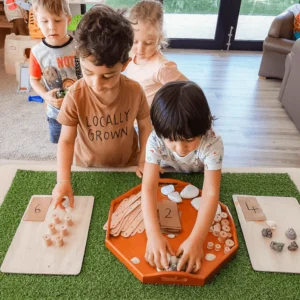In Early Childhood Education, many modern theories highlight the environment as a “third teacher,” recognising how important it is in shaping children’s learning.
According to Nature Play QLD, “Young children explore their world with all of their senses through hands on experiences, they see their evolving creations, the colours, the patterns, they feel the textures of the materials; the soft petals, the rough bark, smooth stones, and smell the fragrant leaves and flowers.”
As early childhood educators, we have a vital role in integrating natural resources into playspaces, providing children with opportunities to explore, create, and engage their senses, as well as nurture their curiosity and foster a deeper understanding of the natural world around them.
Introduction of Natural Materials in Children’s Learning
5 Evidence-Based Benefits of Using Natural Resources in Children’s Play
As early childhood educators, we see first-hand how natural environments enrich children’s learning and development. Time spent outdoors with hands-on experiences not only nurtures exploration but improves a child’s focus, problem-solving abilities, and a deeper connection to the world around them.

Photo: investigating insects and bugs at Busy Bees at Maroochydore (QLD)
By incorporating natural materials into our early learning programs, five meaningful learning benefits are created.
- Creativity – Natural materials stimulate creativity and imagination by providing children with open-ended play experiences
- Sensory exploration – Children can explore natural materials with all of their senses. Children can smell the scent of a flower, feel the rough texture of a pinecone, observe the intricate patterns on a lief, or listen to the sound of pebbles clinking together.
- Environmental Awareness – Engaging with natural resources teaches children to care for natural environments and develop respect for living things. Using flowers, shells, stones, fabric, baskets, art prints and other materials in the curriculum helps children to learn to appreciate natural beauty. (Quality Area 3 | The Environment as the Third Teacher)
- Imagination and problem solving – Natural resources have infinite uses in supporting children’s problem solving, scientific inquiry and numeracy skills. For example, when children build structures, they learn to sort and categorise (by size, colour, and texture), problem-solve by (balancing, and stacking), and develop spatial awareness through (arranging, constructing).
- Resourcefulness – Natural resources also allow children to be resourceful and sustainable through finding ways to recycle, re-use and repurpose items in their play. This provides opportunities for children to problem solve and be creative in ways that develop the respect for the environment and thoughtful use of limited natural resources and sustainability (Quality Area 3 | The Environment as the Third Teacher)

Photo: the children at Busy Bees at Williams Landing (VIC) use natural resources to explore numeracy
How Busy Bees Nurtures Imagination and Discovery Through Nature-Based Play
At Busy Bees, our Services provide many opportunities for children to engage in loose parts play with natural resources. Our Educators create inclusive and engaging natural learning environments, both indoors and outdoors, that inspire children to explore, create, play together and ignite their imaginations and sense of discovery.
We do this in a number of ways, including:
- The inclusion of natural materials in play
- Loose parts play
- Engaging in natural environments
- Access to natural and living things
- Caring for animals within the service
- Bush Kinder programs
Want to know how your nearest Busy Bees Service supports children’s environmental education? Speak to your Service manager or find your nearest location to enquire.
Sources:
https://natureplayqld.org.au/acecqa-nature-play-and-bush-kindy-resources
https://blog.optimus-education.com/using-natural-materials-enhance-children%27s-learning
